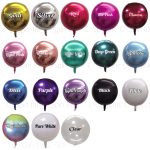Introduction: The Joy of Helium Balloons
Helium balloons are a popular and whimsical addition to celebrations, events, and special occasions. Their ability to float gracefully in the air adds an element of joy and festivity to any environment. However, understanding the factors that influence the lifespan of helium balloons is essential for maximizing their longevity and ensuring they remain aloft for as long as possible. In this article, we’ll explore the science behind helium balloons and provide insights into predicting their lifespan for optimal enjoyment.

The Science of Helium: Why Balloons Float
The key to a helium balloon’s ability to float lies in the physics of buoyancy. Helium is a lighter-than-air gas, which means it has a lower density than the surrounding air. When a balloon is filled with helium, the gas inside the balloon is less dense than the air outside, causing it to float upward. This buoyant force counteracts the downward pull of gravity, allowing the balloon to defy gravity and remain suspended in the air.
Factors Affecting Balloon Lifespan: Size, Material, and Environment
Several factors influence the lifespan of helium balloons, including their size, material, and the environment in which they are placed. Larger balloons typically contain more helium gas, which provides greater buoyancy and allows them to float for longer periods. Additionally, the material of the balloon can affect its lifespan, with high-quality latex or Mylar balloons lasting longer than cheaper alternatives.
The environment in which the balloon is placed also plays a significant role in determining its lifespan. Exposure to sunlight, heat, wind, and other environmental factors can cause helium balloons to degrade more quickly. Direct sunlight can cause the balloon material to become brittle and prone to bursting, while exposure to high temperatures can cause the helium gas to expand and escape more rapidly.

Predicting Lifespan: Understanding Helium Leakage
One of the primary factors that determine the lifespan of a helium balloon is the rate of helium leakage from the balloon. Over time, helium gas molecules are small enough to diffuse through the pores of the balloon material, causing the balloon to gradually lose buoyancy and descend to the ground. The rate of helium leakage depends on various factors, including the quality of the balloon material, the size of the balloon, and environmental conditions such as temperature and air pressure.
While it’s challenging to predict the exact lifespan of a helium balloon due to these variables, certain factors can provide insights into its longevity. For example, Mylar balloons tend to retain helium gas more effectively than latex balloons due to their impermeable material. Similarly, larger balloons with a higher volume of helium gas will generally float for longer periods than smaller balloons.
Extending Lifespan: Tips for Prolonging Balloon Float Time
Although the natural lifespan of helium balloons is finite, there are steps you can take to prolong their float time and maximize enjoyment. Placing balloons indoors away from direct sunlight and heat sources can help prevent premature degradation of the balloon material and slow the rate of helium leakage. Additionally, tying balloons to weighted objects or using balloon weights can prevent them from drifting away and help maintain their position in the desired location.
Regularly inspecting balloons for signs of deflation or damage and replacing them as needed can also help ensure a consistent and visually appealing display. Keeping spare balloons on hand allows for quick replacements when necessary, ensuring that your decorations remain vibrant and festive throughout your event or celebration.

Exploring Alternative Filling Methods
While helium is the most commonly used gas for inflating balloons, there are alternative filling methods that can extend the lifespan of balloons and enhance their visual appeal. One such method is using a mixture of helium and air to inflate balloons, known as “dilution.” By diluting the helium with air, the rate of helium leakage is reduced, allowing balloons to float for longer periods. This technique is particularly useful for large-scale balloon installations or events where a prolonged float time is desired.
Another alternative filling method is using a lightweight gas such as hydrogen or nitrogen to inflate balloons. While helium is non-flammable and safe for use indoors, hydrogen and nitrogen offer similar buoyancy properties and can be more cost-effective alternatives. However, it’s essential to exercise caution when using hydrogen, as it is highly flammable and should only be used in well-ventilated outdoor spaces under proper supervision.
Enhancing Durability with Sealants and Coatings
To further extend the lifespan of helium balloons and protect them from environmental factors, consider using sealants or coatings designed specifically for balloon surfaces. These products create a protective barrier that seals the pores of the balloon material, reducing helium leakage and increasing resistance to damage from sunlight, moisture, and abrasion. Sealants and coatings are available in spray or brush-on formulas and can be applied to balloons before or after inflation for added durability and longevity.

Utilizing Temperature Control Techniques
Temperature control techniques can also play a significant role in prolonging the float time of helium balloons. For outdoor events or installations exposed to direct sunlight and high temperatures, consider implementing shading devices or canopies to protect balloons from excessive heat and UV radiation. Additionally, using fans or air conditioning to maintain cooler indoor temperatures can help slow the rate of helium leakage and preserve balloon buoyancy.
Monitoring and Adjusting as Needed
Throughout the duration of your event or celebration, it’s essential to monitor the condition of helium balloons and make adjustments as needed to maintain their buoyancy and visual appeal. Periodically check balloons for signs of deflation, damage, or shifting due to changes in environmental conditions. Add additional helium or air as necessary to compensate for helium leakage and ensure that balloons remain aloft and evenly spaced for the duration of the event.
Recycling and Proper Disposal
Once your event or celebration has ended, it’s essential to properly dispose of helium balloons to minimize environmental impact and promote sustainability. While balloons can be a source of joy and celebration, they can also pose a risk to wildlife and ecosystems if not disposed of responsibly. Consider implementing recycling programs or initiatives that encourage guests to return used balloons for proper disposal or recycling. Alternatively, biodegradable balloons made from natural materials offer a more environmentally friendly option that decomposes harmlessly over time.

Conclusion: Enhancing the Joy of Helium Balloons
In conclusion, understanding the factors that influence the lifespan of helium balloons is essential for maximizing their float time and enhancing the enjoyment of special occasions. By considering factors such as balloon size, material, environment, and helium leakage rate, you can make informed decisions when selecting and displaying balloons for your events. By following tips for prolonging balloon lifespan and taking proactive measures to maintain their buoyancy, you can create memorable and visually stunning displays that captivate and delight guests of all ages. With a little knowledge and preparation, you can ensure that your helium balloons bring joy and festivity to any celebration or gathering.


